
Curator’s statement
As an avid traveler, I decided to book a road trip through southern Spain with my two young daughters and husband. I busied myself with research and itinerary planning when a fear of naiveté wedged its way into my mind. Was I crazy for taking two kids on an international road trip? Would it become a chore rather than the adventure I imagined? I'm happy to report that my initial confidence led to a treasured family trip we will remember for years to come. The Spanish people naturally embrace children, which made our boisterous kids feel right at home. Our daughters were met with smiles and pleasantries throughout our trip, even in quiet restaurants and historical sights. Traveling with small children involves considering their needs, attention spans, and energy levels. Come along as we fly into Valencia, drive to Granada, then Sevilla, showing you all the kid-friendly tips and tricks along the way. Part 2 including white villages & coast coming soon!
The Fora Difference
Book with Katie to access exclusive perks and experiences on your trip.
Killer perks
Free upgrades, spa credits and more—we got you
Personalized recs
Customized travel planning for your style
Insider knowledge
Expert advice from people who’ve actually been there
Where to stay
Unlock perks by contacting Katie to book your trip.
Day 1: Valencia
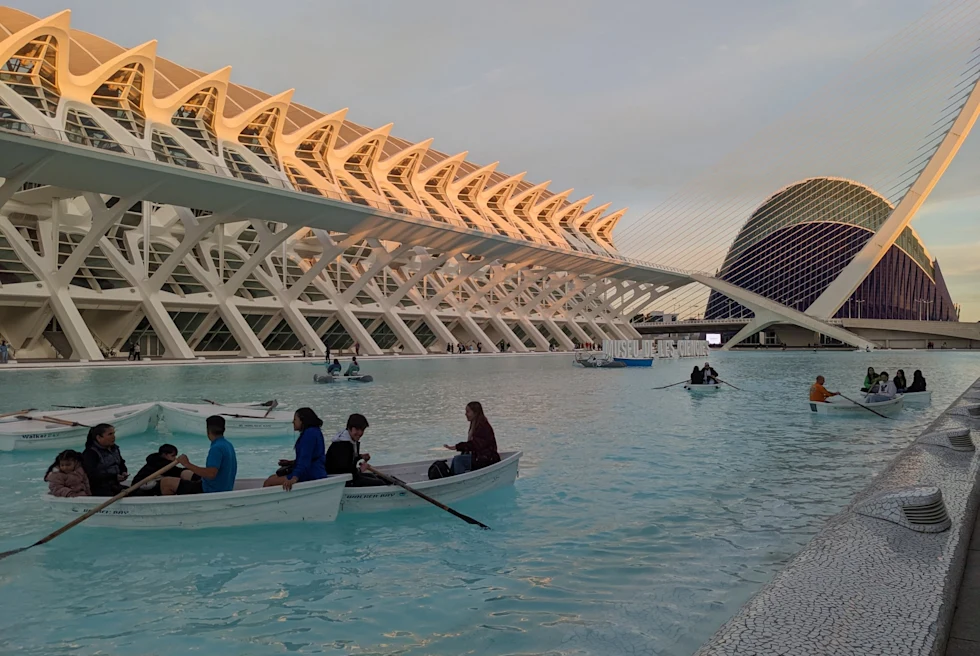
We began our trip in Valencia because of flight availability. While not typically part of a Southern Spain itinerary, it was a delightful addition to our trip. A 2,000-year-old city surrounded by citrus orchards, sprawling beaches, and eye-catching architecture, Valencia shines due to its bustling food scene and creative culture infused at every turn. Known by some as the city of 100 towers, it is home to the Gothic Miguelete Tower and the Tower of Santa Catalina, an example of the Valencian Baroque style.
Accommodation
Hotel Hospes Palau De La Mar: Located 500 meters from the historic center of Valencia and boasting spacious rooms with copious natural sunlight, the Hotel Hospes De La Mar is family-friendly and conveniently located to area attractions. The hotel was once an original Valencian Manor House, making a stay at this unique hotel like going back to the old world!
Restaurant
La Riua: Our favorite restaurant in Valencia. This eclectic, quintessentially appealing diner offers a blended menu of Mediterranean, Spanish and European dishes with vegetarian and gluten-free options. A well-known Spanish dish often eaten for lunch is Paella, which originated in Valencia and included rice, green and lima beans, rabbit, and chicken. This was one of our girls' favorite meals, as evidenced by their propensity to forgo silverware and eat it by the handful. Traditionally eaten at lunch, I recommend accompanying your Paella with the Spanish wine Sureo Sangria on tap. Reservations are highly recommended.
Santa Catalina Horchata
Santa Catalina Horchata is famous for its horchata, a milky sweet drink made from ground almonds and tiger nuts. Our daughters were motivated to walk a little longer at the prospect of anything like an ice cream dish, so horchata immediately won them over! A refreshing drink often enjoyed on the terraces of street cafes in summer, Santa Catalina is an ideal spot to enjoy these delectable sweet treats. They also served hot and delightful fartons: a confectionery dough made with flour, milk, sugar, oil, and eggs and finished with a sweet glaze.
Gullivers Park
Traveling with small children means stopping at parks. Naturally, we planned to stop at Gullivers Park; the draw for kids is a 67-meter-long figure of Gulliver from the classic children's book, Gulliver's Travels, to climb and play on. The playspace is part of Valencia's Turia Park gardens, built on Turia's riverbed, which was rerouted to prevent flooding. The garden grounds feature playgrounds, a pond with rentable boats, a walking path, the City of Arts and Sciences Museum, and a reflection pool. Entrance is complimentary, but capacity inside the park is limited and tends to be crowded on the weekends.
Plaza de la Verge
Dating back to the roman conquest and bustling with street performers, this high-energy square is home to the Turia Fountain, with rows of distinctive buildings and iconic outdoor cafes that delight children and adults. Tip: keep coins handy for kids to tip their favorite performers.
Valencia Water Council
You may want to find yourself in Valencia on a Thursday at noon to observe the Valencia Water Council. Part of the Unesco World Heritage, denoting its cultural significance, for over 1,000 years, this council has been arbitrating water altercations among farmers. As the oldest democratic body in the world, each state district has a representative on the water board. If a resident has a grievance, the representative brings the issue to the water board for resolution. The Valencia Water council is open to onlookers and regularly garners tourists from around the world. Be sure to arrive before noon as the entire council is conducted orally and adjourns quickly, sometimes only lasting five to ten minutes.
Mercado Central Public Market
On the morning of the day we'd be making our longest drive, we decided to break at Mercado Central, Spain's largest public market, which dons old-world architecture and captivates your senses the moment you walk through the artfully designed dome roof. The wildly colorful food stalls usher you along endless rows of fruits, olives, cheeses, bread, sandwiches, and fresh fish. This was the perfect outing to stock up on fresh snacks and stretch our legs before being in the car most of the day. Note: The market is closed on Sundays, and an underground parking garage is nearby.
After wandering the market, we were hungry for an early lunch, so we stopped at a nearby restaurant called Boatella Tapas. It had outdoor patio seating, umbrellas, heaters, and an indoor dining room. You can view most of their dishes in the outdoor case while walking by. We recommend fried shrimp, "gambas frits" in Spanish, and fried anchovies and ice cream. One plus to traveling in Spain with children is that the food prices are affordable compared to other European cities. This made us more prone to order local specialties for our picky eaters to try; if they didn't like it, we hadn't spent excessive money.
Day 2: The drive from Valencia to Granada
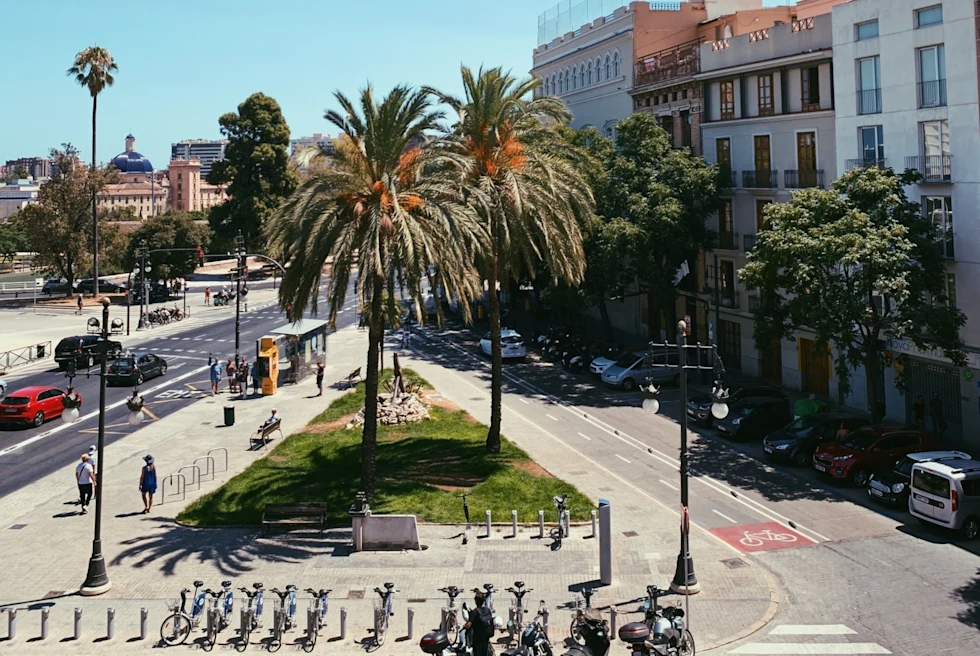
The drive from Valencia to Granada is a five-hour trek, approximately 305 miles. The highway route takes you along the coast with opportunities to stop and explore. Renting a car at the airport was an easy option for transportation right after landing in Valencia.
Note: the speed limit varies and is monitored via cameras. How did we find this out, you ask? We received a bill for three speeding tickets a few weeks after arriving home. Thankfully the tickets were inexpensive but be aware that your speed is being monitored!
Day 3: Granada
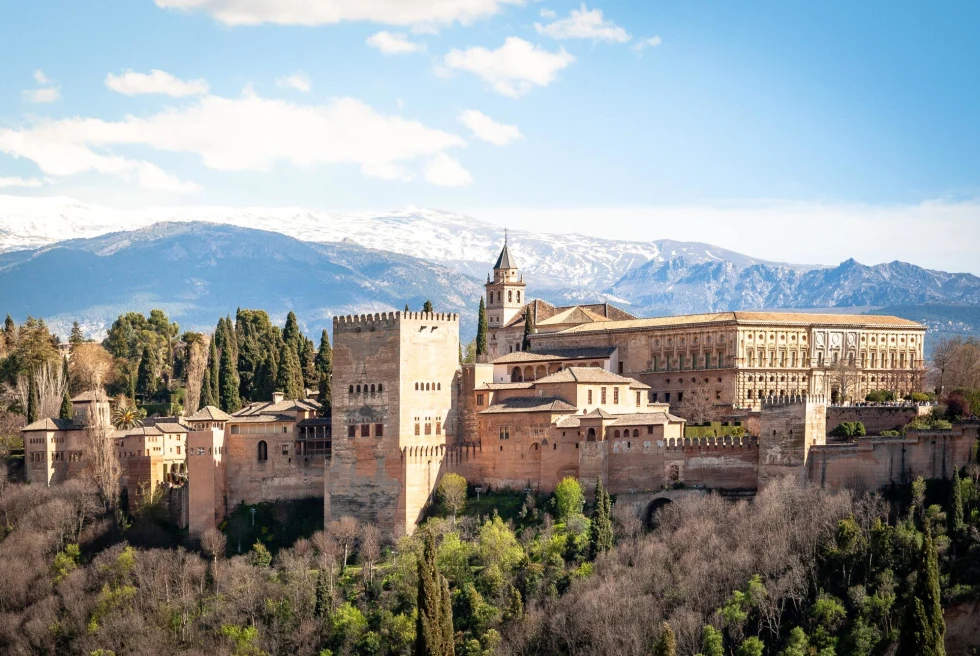
Granada is a harmonious blend of breathtaking views, from the majestically situated castles on lush hillsides to the contrasting colors of masterfully designed old-world buildings against the ethereal backdrop of the sky. One minute you are walking through a palace, marveling at the intricate aesthetics of the interiors. The next minute you peek out the window to encounter the sun-spun colors of the exquisite landscape against the aura of the dreamy town. I did double-takes at every turn.
Accommodations
Hotel De Los Patos: Located within an old palace, Hotel De Los Patos is centrally positioned in the historic center of Granada. It seemed fitting to stay in an old palace in a city known for its beautiful palaces. I recommend booking a room in the historical section or the newer part of Hotel De Los Patos next door. A lovely courtyard filled with citrus trees beckons, so sit awhile and relax while ordering a drink from the outdoor bar. I enjoyed the pleasant surprise of available cozy robes and snuggly slippers on a rainy night. It's the little things.
Restaurants
EntreBrasas: The tapas bar, Mas Que Vinos, was on our planned itinerary for dinner, but we changed plans when we walked by EntreBrasas tapas bar and were swept away by the roadside charm of this little gem. A unique feature of this narrow restaurant was that some tables were for ordering menu items, and others were exclusively for tapas. We ordered drinks, and soon our tabletop became a tapas feast. I recommend the homemade vermouth and vino tinto from the drinks menu. The food was incredible. The staff was friendly, and our children felt welcome. We were pleased with our change of plans. Let that remind you to infuse your itinerary with a healthy dose of spontaneity!
Alhambra
The Alhambra is an architecturally stunning medieval Palace that has withstood the test of time. A famous monument blending Islamic and Spanish Renaissance architecture, it is one of the best-preserved Palaces of the old world. Touring the La Alhambra reveals intricate Arabic script engraved into the walls, detailing stories and poems which give insight into the leaders who dictated hundreds of years ago.
Nestled in the mountains of Granada, the palace began being built in 1238 as a fortress. The water features around the property were both visually stunning and functional. We were touring with children, and it took a lot of work to learn in-depth about the property's historical significance due to distractions or needed potty breaks. If you plan to visit Alhambra with children, I recommend studying Alhambra to understand and appreciate water utilization throughout the property. Most of Alhambra is ticketed and limited, so I recommend purchasing advanced tickets. Keep in mind entry is timed for a portion of the property.
Flamenco
While Granda can be visited on a day trip, I recommend staying one night so you can catch Cueva de la Rocia. A Flamengo dance show in a whitewashed cavern, Cueva de la Rocia, mesmerized our girls, and they were amused by the cave dwelling. Granada was historically home to the Roma people and the birthplace of the Flamenco dance; this part of town experienced substantial flooding that led to a decline in its population; however, the people are resilient and continue to live in the cave homes & come to study Flamenco dance.
The city of Granada is considered the birthplace of Flamenco. This Spanish art form incorporating song, dance, and music usually features guitar music, hand-clapping, and heel stomps, danced by male and female duos in traditional Spanish costumes. I had read that sometimes children are frightened by the dancing, but this wasn't our experience - my girls were mesmerized by it. The hour-long show proved to be the perfect length. Some shows are louder and more sensual, but Cueva de la Rocia is authentic and intimate, perfect for all ages. We were glad we spent the night and enjoyed the evening experience.
Day 4: The drive from Granada to Seville, with a midway stop in Corboda
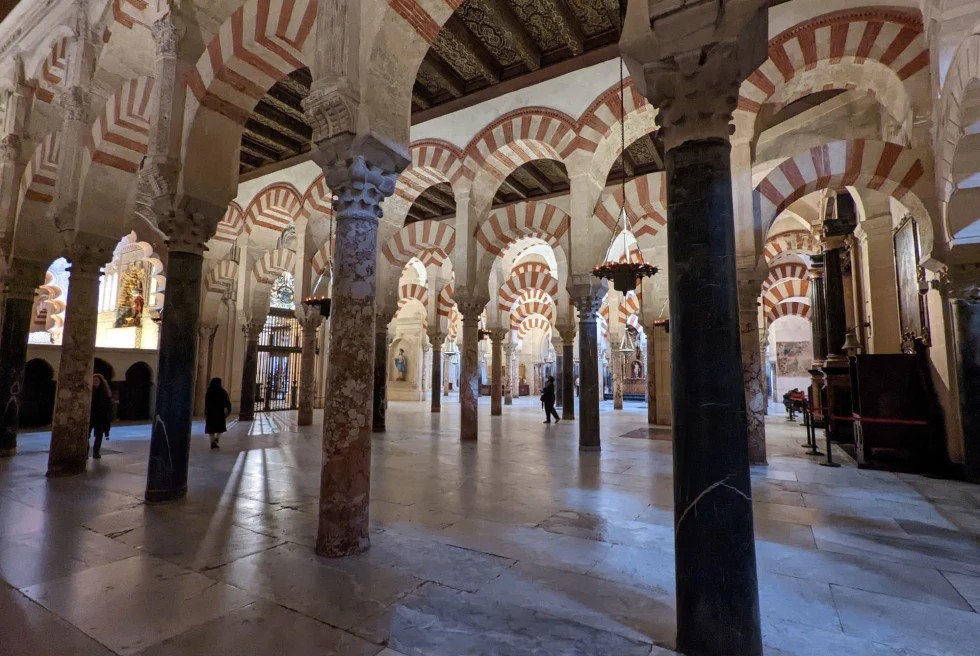
The drive from Granada to Seville is two hours and thirty-three minutes, so we split the trip by slightly over an hour with a stop in Corboda, affectionately called the city of flowers. The scenery was magnificent mountains and open valleys stretching as far as the eyes could see.
I wanted to see the La Mezquita-Catedral de Cordoba and its exquisitely designed architecture in the large cathedral with small churches intertwined. For a leisurely lunch, we purchased a large side of tortilla espanola from Bar Santos, which we ate beside the Mezquita wall.
Caliphal Baths is a historical site with Arabic baths that have been turned into a museum that would be a neat site to add to a Cordoba trip. After site seeing and lunch, we made the hour-and-a-half trip to Sevilla, as the kids took a backseat nap. My husband and I enjoyed the quiet, scenic drive.
Day 5: Sevilla
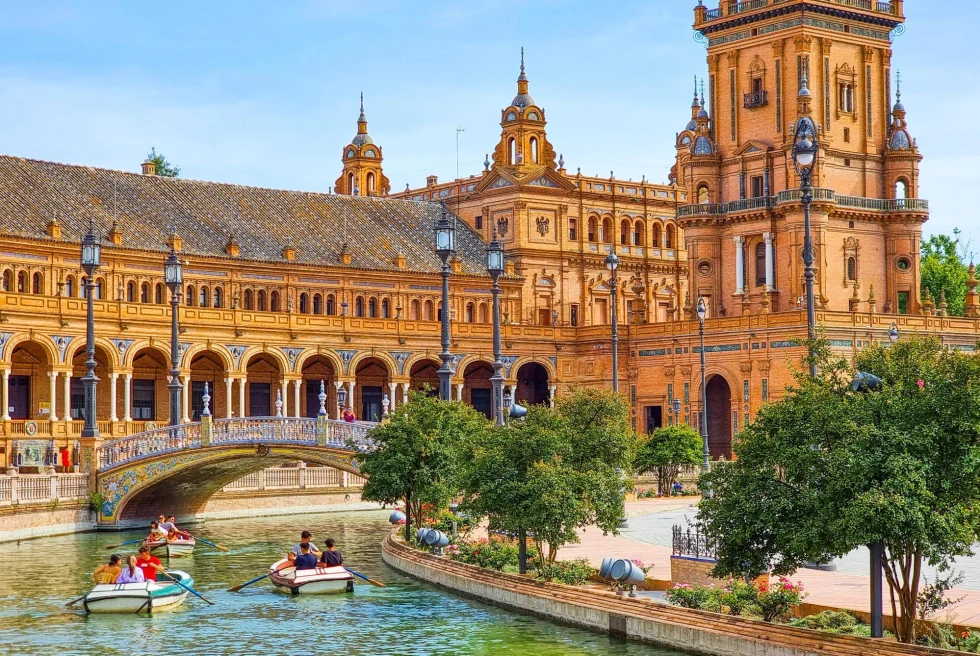
Sevilla is the third largest city in Spain and a destination popular with travelers. It's been called the most important southern Spanish city in political, cultural, economic, and the arts arenas. It was Spain's center of commerce during the conquistador's times. Stay in Sevilla for a day longer than in Granada, as the vast history invites you to linger longer. You could easily spend three days seeing all the local attractions. Important to note the average summer temperature in Sevilla is 96 degrees Fahrenheit, making it a sweltering summer destination. If traveling in the Summer, plan your day to involve respite with siestas and hotel pools.
Accommodations
Hospes Las Casas Del Ray: Our hotel's location, Hospes, was just outside the city center, providing a neighborhood feel and a welcome escape from the endless tourists exploring Sevilla. The hotel was once a multi-family property, including several courtyards, but has since been transformed into a modern hotel that maintains its original intimate feeling of gathering with friends. Cozy seating areas invite you to linger over wine and conversation. Amenities include a rooftop pool with a city view, perfect for a dance party - my daughter's favorite - or a glass of Spanish wine. As a cautious mom, I appreciated that the railing was high and safe for toddlers. When we arrived in Seville, we needed a quiet night in. This hotel is perfect for a respite evening; we ordered pizza from nearby restaurants in our quiet room, enjoying the small balcony. You could also enjoy a takeout dinner in one of the internal courtyards. Of course, as always with Hospes properties, the high-quality breakfast buffet with eggs made to order filled my girl's bells, and I enjoyed the cappuccinos and cava to start my day.
Restaurants
A delicious indulgence for us was Catalina Casa, my husband and I took turns eating tapas and drinking Spanish wine. At the same time, our girls were entertained by the playground out front. The restaurant displays fresh produce, adapting its menu based on the season.
A Carriage Ride through the Sites
For your first day in Seville, I suggest a horse-drawn carriage ride around the main sites of Seville to get a valuable overview of the city you are visiting. The carriage rides begin in the Old Quarter and cost 50 euros for 45 minutes. The drivers will point out a few key sites but only sometimes provide commentary, like a tour guide. The carriage will likely take you by Plaza De Espana and Maria Luisa Park, beauty meccas of the city. You'll see the Statue of Bequer and the El Cid Campeador Monument and ride by the Lope de Vega Theater. You'll also pass by the pavilions of the Iberian American Exhibition of 1929. Lastly, the ride should include the Alcazar Royal Palace, the Cathedral of Seville, and the Giraldi Bell Tower.
For a detailed city tour, ask your advisor to arrange a private tour with Context Travel.
Part of the horse-drawn carriage ride is through the gardens, a lavish gift to the city by a benefactor. We noted that the gardens' large ungated property is perfect for wandering under lush trees and viewing fountains and statues. Bicycle buggies can be rented to pedal around the property. The setup is ideal for a family!
La Plaza de Espana
The epicenter of the gardens is the Plaza de Espana. In 1929, Seville hosted the Ibero-American Exposition World's Fair. The Plaza de España was built in Maria Luisa Park (Parque de María Luisa). This expansive horseshoe-shaped structure features benched seating areas decorated with art depicting each state in Spain. A waterway flows around the space with row boats for rent. You will likely see flamenco dancers entertaining those marveling at the architecture of the Plaza built for the World's Fair.
El Alcazar
Take advantage of the Alcazar palace while in Spain! The historic Alcazar property is ticketed, and I recommend purchasing tickets online to reduce wait time. If you're a Game of Thrones fan, you may enjoy knowing that Alcazar was a filming location for the Water Gardens of Dorne. Plan to spend a few hours wandering the nature-filled gardens and palaces. My children loved the hedge maze - it was a great way to get some physical movement while seeing a historical landmark. An audio tour would work well for this location.
We culminated our trip by spending four days traveling along the coast, returning to Valencia, and stopping in several quaint coastal towns. Look for my Spain guide, part 2.
Need to know
Tips and tricks for traveling with kids in Spain
Here are a few things we did with our daughters, ages two and four, to make traveling to Spain a breeze. Just kidding, is traveling with kids ever a breeze? No, but it's full of adventure!
Jet Lag
Most flights from the US to Europe arrive in the morning. I plan fun activities for our arrival time, so we aren't tempted to go to bed early. A good rule of thumb is a fun lunch or outing followed by outside time; natural light helps the body acclimate to the time zone. Then we are ready for bed at the regular local bedtimes. Jetlag is toughest on adults, and relaxation is vital to adjusting to a new time zone. Limiting the number of timed-entry activities on the first day is helpful to maintain flexibility.
Adjusted bedtime
We adjusted bedtime to fit the Spanish meal schedule; this also helped to reduce the transition time once home. The first day we stayed up and had our kids in bed within an hour of our target bedtime to ensure they awoke with plenty of daylight. Our girls were acclimated into Spanish time within a day.
Plenty of Snacks
Any seasoned parent knows that snacks and water are always game changers for travel. There are endless options for purchasing fresh bread, meats, and cheeses in Spain, and with citrus trees all around, you can pick fresh oranges as you walk for a vitamin C pick-me-up! I carried reusable water bottles and asked for cups of water at restaurants to fill up our bottles.
Strollers and carriers and car seats
I opted not to use a stroller due to the cobblestone streets in old towns. We brought a carrier for the two-year-old, and the four-year-old walked and was occasionally carried on her dad's shoulders when she became tired. We checked two car seats for free and used the car seat space to hold our diapers and wipes, that way, we could continue with our usual brands. Our car rental agency also has a car seat rental option if you want to avoid checking your personal seats.
Luggage
We only brought carry-ons apart from the checked car seats. Each airline has a specific carry-on size allowed, so be sure to know before packing. We washed clothing three times, once at the lodging and twice at the laundromats. Having easy-to-carry luggage makes packing and changing hotels easy. It is a bonus if the toddler can ride on the carry-on!
Language
I always try to learn a few words in the language native to wherever I travel. I find locals appreciate it or at least get a good laugh at my pronunciation! While I speak Spanish & consistently use it while traveling in Spain, my husband does not. Most hospitality professionals speak fluent English, allowing them to interact with people easily. Google Translate is an excellent option if you don't speak Spanish and need an app. While my girls played in parks, Spanish children would talk to them, and they couldn't communicate verbally, but it didn't stop them from playing. For future trips, I would like to add Language classes to our travels so they can learn basic phrases to use on our journey.

Travel Advisor
Katie Stuhr

Get in touch with Katie
Did you like this guide? Reach out to customize and book your own experience. Or, just to chat about travel in general.
You can expect a response from Katie within 1–2 business days. You’ll also be subscribed to our traveler newsletter (you can unsubscribe at any time).
For more travel tips, check out Fora Advisor Juli Hall's guide, 3 Family-Friendly Days in Barcelona.
This guide is part of our ongoing series on travel to Spain.